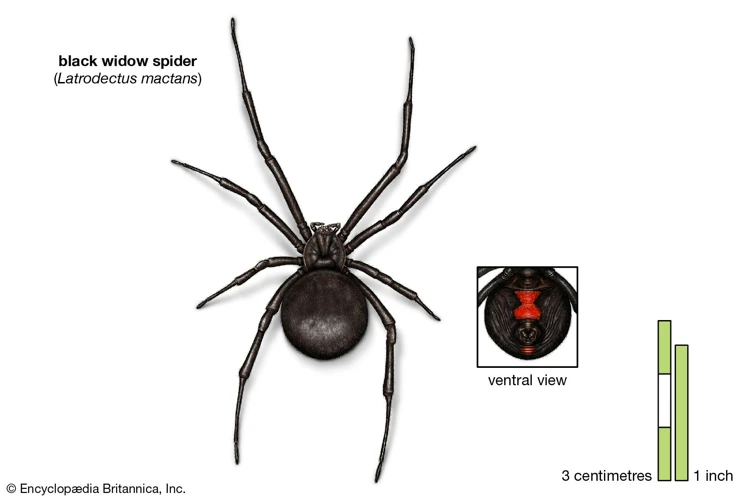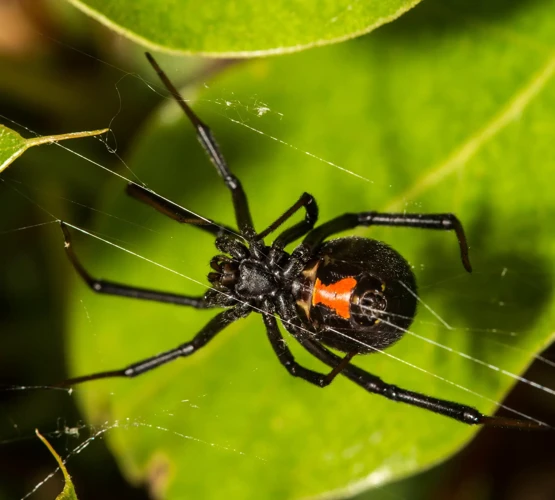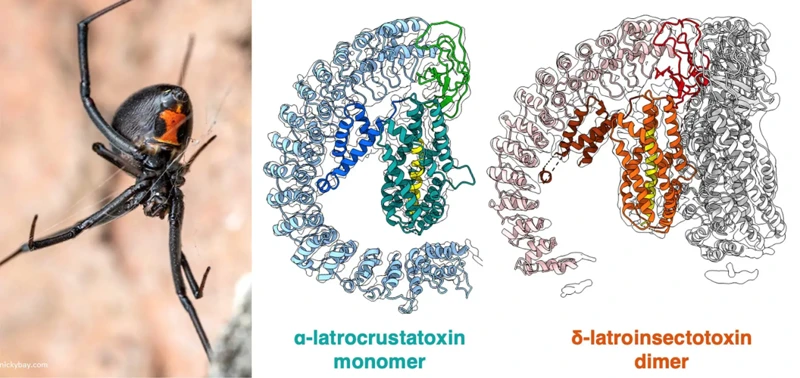It’s a fact that black widow spiders are one of the most well-known venomous creatures on the planet. What makes them so fascinating, however, is the mystery surrounding their venom gland. Despite decades of research, scientists are still unravelling the secrets hidden within this potent weapon. In this article, we will explore the anatomy and characteristics of black widow spiders, the function and effects of their venom, and what to do if you have a human encounter with these stealthy predators. Get ready to delve into the captivating world of the black widow spider and its venom gland.
Anatomy and Characteristics of Black Widow Spiders

Unraveling the Anatomy and Characteristics of Black Widow Spiders
Black widow spiders are renowned for their distinctive appearance and powerful venom. Understanding the anatomy and characteristics of these arachnids is crucial for anyone who wants to avoid their painful bite. From their unique markings to the structure of their venom gland, black widow spiders are fascinating creatures that warrant closer inspection. In this section, we will explore the key features of black widow spiders, including their anatomy, venom, and behavior.
Overview of Black Widow Spiders
Black widow spiders belong to the genus Latrodectus, and there are several species found across the globe. The most common species found in North America is the southern black widow spider (Latrodectus mactans). These spiders are known for their distinctive appearance, with shiny black bodies and a red hourglass-shaped marking on their abdomen. The males are smaller than the females and have less pronounced markings.
Black widow spiders are found in temperate regions and prefer dark, sheltered areas like homes, garages, and woodpiles. They use sticky webs that are irregularly shaped and tangled, often in undisturbed areas like basements, attics, and crawlspaces. These spiders are most active at night and tend to hide during the day.
While black widow spiders are venomous, they will usually only bite in self-defense. Female black widow spiders are known to be aggressive if they feel their eggs or young are threatened. Generally, black widow bites happen when they are disturbed or accidentally contacted. The venom from their bite is neurotoxic, meaning it affects the nervous system, and can cause a range of symptoms, depending on the amount of venom injected and the person’s sensitivity to the venom.
Structure of Venom Gland
The venom gland of black widow spiders is a crucial part of their anatomy, responsible for producing and delivering the toxic substance that aids in prey capture and protection. This gland is located in the cephalothorax, close to the fangs, and consists of two bulb-shaped compartments that are joined by a long, thin duct.
The first compartment is the secretory portion of the gland, which produces and stores the venom. The second compartment is the duct portion of the gland, which is responsible for delivering the venom to the spider’s fangs.
The venom itself is a complex mixture of proteins and smaller molecules. At least seven different types of protein toxins have been identified in the venom of black widow spiders. These toxins act on the nervous system of their prey, causing muscle contractions and paralysis.
Interestingly, the venom gland of male black widow spiders is not as well-developed as that of females. This is because male black widows do not typically hunt for prey, and their venom is not usually toxic enough to affect humans.
Understanding the structure of the venom gland in black widow spiders is important for studying the composition and effects of the venom. This knowledge can also help in the development of antivenom and other treatments for black widow spider bites.
For more information on how to prevent and treat black widow spider bites, check out our helpful articles on bite prevention and first aid and medical treatment.
Function and Effects of Black Widow Spider Venom

As one of the most feared spiders in the world, the Black Widow Spider is notorious for its venom. The venom is potent and can cause severe symptoms in both humans and animals. In this section, we will examine the function and effects of Black Widow Spider venom. Understanding the effects of the venom can help us better navigate the potential risks associated with these spiders and take necessary precautions. We will also explore the different types of venom found in Black Widow Spiders and how it aids in both prey capture and protection. If you ever find yourself in a situation where you or someone else has been bitten by a Black Widow Spider, we also have valuable information on first aid and medical treatment. But first, let’s take a closer look at the anatomy and characteristics of these spiders.
Types of Venom in Black Widow Spiders
Black Widow Spiders are known for their highly potent venom. The venom of female Black Widow Spiders is more toxic than that of males. These spiders produce two types of venom, which work together to paralyze the prey.
1. Neurotoxic Venom – This type of venom attacks the nervous system of the prey, causing it to be paralyzed. It works by blocking the neurotransmitters from sending signals to the muscles. Neurotoxic Venom also affects the respiratory muscles, which can cause the prey to stop breathing.
2. Cytotoxic Venom – This type of venom attacks the cells of the prey, causing them to break down and die. It affects the red blood cells, which can lead to anemia. Cytotoxic Venom also has the ability to cause necrosis, leading to the destruction of tissue.
While the venom of Black Widow Spiders is harmful to humans, it is not always fatal. However, it can cause serious symptoms such as muscle pain, cramps, and spasms, as well as difficulty breathing. It is important to seek medical attention immediately after a bite, especially if symptoms begin to escalate.
If you want to read more about treating Black Widow Spider bites, you can check out our article about First Aid and Medical Treatment for Black Widow Spider Bites.
How the Venom Aids in Prey Capture and Protection
Black widow spiders use their venom primarily for prey capture and protection. Unlike many other spider species that simply wait for prey to become entangled in their webs, black widow spiders actively hunt and capture their prey. The venom helps the black widow spider to immobilize their prey quickly and effectively, making it easier for them to kill and consume. The venom also serves as a defense mechanism for the spider, helping to ward off potential predators.
The venom of a black widow spider contains a neurotoxin that affects the nervous system of their prey. When injected into the prey, the venom quickly spreads throughout the body, causing a variety of symptoms such as paralysis and muscle spasms. The venom is composed of a complex mixture of toxins, including alpha-latrotoxin and latrodectin, which work together to produce the desired effects.
When hunting, black widow spiders use their powerful legs to wrap their prey tightly in silk, effectively immobilizing them. They then deliver a bite, injecting their venom into the prey. The venom begins to take effect almost immediately, rendering the prey unable to move or struggle. The spider can then take its time to consume the prey at its leisure. This process is particularly effective when hunting larger prey, such as moths, beetles, and even small rodents.
However, it is important to note that while black widow spiders are venomous, they are not typically aggressive towards humans. In fact, most bites occur when the spider is accidentally disturbed, such as when a person unknowingly brushes up against a web. That being said, it’s important to take precautions when in areas where black widow spiders are known to be present. This can include wearing protective clothing and using insect repellent, as well as avoiding known spider habitats.
The venom of the black widow spider is a highly specialized tool that helps the spider to capture prey and defend itself against predators. While it can be dangerous to humans in some cases, the spider’s natural behavior makes it unlikely that people will be bitten unless they come into direct contact with the spider or its web.
Human Encounters with Black Widow Spiders
When encountering a black widow spider, it’s important to stay calm and take necessary precautions. Black widow spiders are notorious for their venomous bites, which can cause symptoms ranging from mild pain to more severe reactions. These spiders can be found across many regions of the world and it’s essential to be able to accurately identify them in order to avoid potential encounters. In this section, we will take a closer look at how to identify black widow spiders and their habitat, as well as first aid and medical treatment options for those who have been bitten.
Identification and Habitat of Black Widow Spiders
Identification and Habitat of Black Widow Spiders
Black widow spiders are most commonly found in warm climates. They can be identified by their shiny black appearance, round abdomen, and distinctive red hourglass shape on the underside of the female spider’s abdomen. Male black widow spiders are smaller and have a uniform dark brown color.
There are five species of black widow spiders in North America. The most common species found in the United States is the southern black widow spider, which is typically found in the southeast region of the country. The western black widow spider is another common species and is usually found in the western United States.
These spiders tend to gravitate to areas that are dark, dry, and undisturbed. They can be found in a variety of locations such as woodpiles, garages, sheds, and abandoned buildings. Black widow spiders can also often be found in outdoor spaces such as gardens and along fence lines.
If you are unsure if you have spotted a black widow spider, it is best to stay away and not attempt to handle or capture the spider. Instead, educate yourself on ways to identify black widow spider webs as an indicator of their presence. If you do suspect a black widow spider bite, seek medical attention immediately.
Common Habitat Characteristics
Here is a table highlighting the common characteristics of black widow spider habitats:
| Habitat Characteristic | Description |
|---|---|
| Darkness | Black widow spiders prefer dark spaces that are undisturbed. |
| Dryness | Black widow spiders thrive in dry environments and can often be found in areas with low humidity. |
| Undisturbed Spaces | These spiders can be found in undisturbed spaces such as garages, sheds, and abandoned buildings. |
| Gardens and Fences | Black widow spiders can be found in outdoor spaces such as gardens and along fence lines. |
If you have any concerns about black widow spiders in your area, it is important to take outdoor precautions to avoid potential bites. You can learn more about this topic in our article on outdoor precautions for black widow spider bites.
First Aid and Medical Treatment for Black Widow Spider Bites
Black widow spider bites can be extremely painful and can have serious effects on the body. If you suspect that you have been bitten by a black widow spider, seek medical attention immediately. In the meantime, there are a few steps you can take to alleviate the symptoms of a black widow spider bite.
First Aid for Black Widow Spider Bites:
| Step | Action |
|---|---|
| 1 | Wash the bite area with soap and water |
| 2 | Apply a cold compress to the affected area to help reduce pain and swelling |
| 3 | Elevate the affected area to help reduce swelling |
| 4 | Take an over-the-counter pain reliever, such as ibuprofen or acetaminophen, to help manage pain |
| 5 | Stay hydrated by drinking plenty of water |
It is important to note that home remedies, such as applying heat or suction, can actually make the symptoms of a black widow spider bite worse. Avoid these remedies and seek medical attention as soon as possible.
Medical Treatment for Black Widow Spider Bites:
If you have been bitten by a black widow spider, your doctor may administer anti-venom medication to neutralize the effects of the spider’s venom. This medication is typically given through a vein in your arm and can be very effective in reducing symptoms.
In addition to medication, your doctor may also recommend pain management techniques and other supportive therapies to help manage your symptoms. These may include:
- Pain relievers to manage discomfort and reduce inflammation
- IV fluids to help prevent dehydration and maintain blood pressure
- Muscle relaxants to help prevent muscle spasms and cramps
- Oxygen therapy to help prevent respiratory distress
It is important to seek medical attention as soon as possible if you suspect that you have been bitten by a black widow spider. Delayed treatment can increase the risk of serious complications and may lead to long-term health problems.
Fortunately, with prompt medical attention and proper treatment, most people recover fully from black widow spider bites. If you live in an area where black widow spiders are common, take steps to avoid their bites by wearing protective clothing, inspecting your surroundings carefully, and seeking professional pest control services if needed.
Conclusion
Unraveling the mystery of the venom gland in black widow spiders is fascinating and full of intriguing information about these creatures. Despite their infamous reputation, black widow spiders play an essential role in their ecosystem and have unique adaptations, such as their venom gland, that contribute to their survival.
Through a better understanding of the anatomy and function of black widow spider venom, we can respect these creatures and take the necessary precautions to avoid negative interactions with them. In the event of a black widow spider bite, it is crucial to seek medical attention immediately and follow first-aid procedures.
If you ever come across a black widow spider, do not be alarmed, but keep a safe distance and try to identify it by its web. Knowing how to identify black widow spider webs can help prevent accidental bites.
Overall, learning about black widow spiders is a fascinating journey that includes everything from their mating rituals to understanding how black widow antivenom is created. By delving into the details of these creatures, we can gain a better understanding of how they co-exist with humans and their essential role in the ecosystem.
Frequently Asked Questions
What is the venom gland in black widow spiders?
The venom gland is a specialized organ in black widow spiders that produces and stores venom.
What are the characteristics of black widow spiders?
Black widow spiders are typically shiny black with a distinctive hourglass-shaped red or yellow marking on their abdomen. They are also known for their unique web-spinning abilities.
What is the structure of the venom gland in black widow spiders?
The venom gland in black widow spiders is elongated and situated dorsally at the anterior end of the abdomen. It is a soft, white gland with a flattened ribbon-like structure.
What are the different types of venom found in black widow spiders?
Black widow spiders produce several types of venom, including neurotoxins, anti-coagulants, and proteases. The neurotoxins are the most potent and are responsible for the spider’s deadly bite.
How does black widow spider venom aid in prey capture and protection?
Black widow spider venom is designed to subdue prey and protect the spider from predators. The neurotoxins cause muscle paralysis, while the proteases work to break down the prey’s tissues for easier consumption.
What does a black widow spider bite feel like?
A black widow spider bite can produce immediate and intense pain, as well as muscle cramps, seizures, and nausea.
What should I do if I am bitten by a black widow spider?
You should seek immediate medical attention if you are bitten by a black widow spider. Applying ice and taking over-the-counter pain relievers can help manage symptoms until medical help arrives.
Where are black widow spiders commonly found?
Black widow spiders are commonly found in warm, dry regions around the world. In the United States, they are found primarily in the southern states.
What is the best way to identify a black widow spider?
A black widow spider can be identified by its shiny black body and distinctive hourglass-shaped marking on its abdomen. However, it is best to leave identification to trained professionals to avoid potential bites.
Can black widow spider venom be fatal to humans?
While most black widow spider bites do not result in death, their venom can be fatal to humans in rare cases. It is important to seek medical attention immediately if you suspect you have been bitten.






